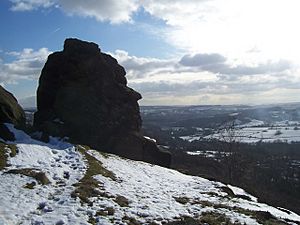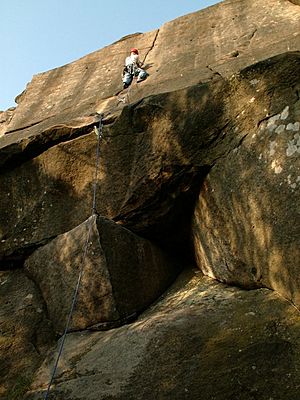Froggatt Edge facts for kids
Froggatt Edge is a cool rocky cliff made of a type of sandstone called gritstone. It's located in the Dark Peak area of the Peak District National Park in Derbyshire, England. You'll find it close to the villages of Froggatt, Calver, Curbar, Baslow and Grindleford.
Froggatt Edge is actually just the northern part of a longer cliff system. The middle section is called Curbar Edge, and the southernmost part is Baslow Edge. Like many similar places in this area, it's easy to get to from the city of Sheffield.
Contents
What Makes Froggatt Edge Special?
Amazing Views and Landscape
This rocky cliff forms the eastern edge of the River Derwent valley. When you look up from the valley below, you can see its rocky towers standing out against the sky.
Above the cliff is a beautiful heather moor. This moor turns a vibrant purple color in late summer when the heather blooms. Sometimes, parts of the moor are carefully burned. This helps new heather grow and stops trees from taking over the open land. Below the cliff, you'll find a forest of birch trees that stretch down towards the River Derwent. From Froggatt Edge, you get amazing views of both the moorland and the valley below.
Unique Gritstone Features
The paths along the top and bottom of the cliff often show the gritstone rock underneath. Over time, many feet walking on these paths have worn down the rock. This creates a warm-colored sand that is special to this part of the Peak District.
Long ago, Froggatt Edge, like other gritstone cliffs in the Peak District, was a place where people found rocks to make millstones. These large, round stones were used to grind grain. You can still find some half-finished millstones at the bottom of this and other cliffs in Derbyshire.
Fun Activities at Froggatt Edge
Rock Climbing Challenges
Froggatt Edge is a very popular spot for rock climbers all year round. It offers many exciting routes for climbers of different skill levels.
Famous climber Joe Brown made two classic routes popular in the late 1940s: Sunset Slab and Three Pebble Slab. While these climbs are not extremely hard, they require skill and careful movement.
One of the most famous climbs at Froggatt Edge is "Downhill Racer." This climb is a smooth, almost vertical slab of gritstone, about 17 meters (50 feet) tall. It was first climbed in 1977 by Pete Livesey. This climb was a big deal because it was both very difficult and quite challenging. There aren't many places to attach safety ropes, so climbers need to be very precise. It is now graded E4 6a, which means it's for very experienced climbers.
Enjoying a Walk
Besides climbing, Froggatt Edge is also a fantastic place for hillwalkers. There are paths along the top and bottom of the cliff, offering different views and experiences. It's a great place to explore the outdoors and enjoy the fresh air.



